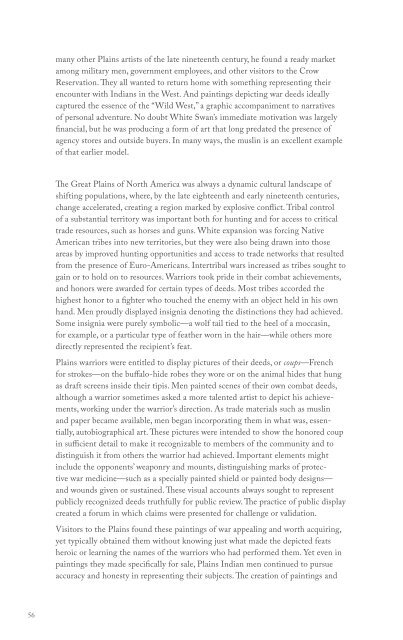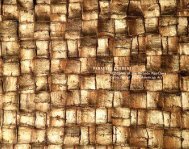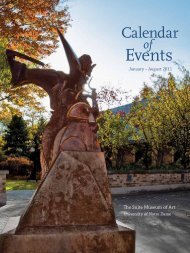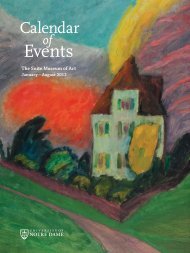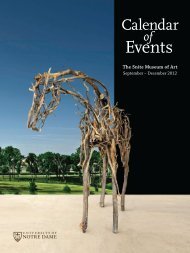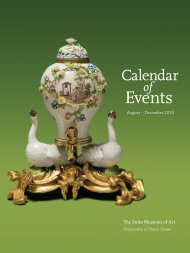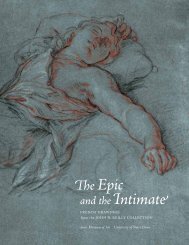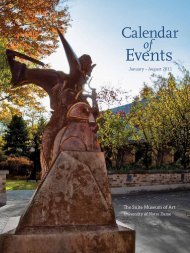HISTORY INTO ART AND ANTHROPOLOGY - Snite Museum of Art ...
HISTORY INTO ART AND ANTHROPOLOGY - Snite Museum of Art ...
HISTORY INTO ART AND ANTHROPOLOGY - Snite Museum of Art ...
Create successful ePaper yourself
Turn your PDF publications into a flip-book with our unique Google optimized e-Paper software.
many other Plains artists <strong>of</strong> the late nineteenth century, he found a ready market<br />
among military men, government employees, and other visitors to the Crow<br />
Reservation. They all wanted to return home with something representing their<br />
encounter with Indians in the West. And paintings depicting war deeds ideally<br />
captured the essence <strong>of</strong> the “Wild West,” a graphic accompaniment to narratives<br />
<strong>of</strong> personal adventure. No doubt White Swan’s immediate motivation was largely<br />
financial, but he was producing a form <strong>of</strong> art that long predated the presence <strong>of</strong><br />
agency stores and outside buyers. In many ways, the muslin is an excellent example<br />
<strong>of</strong> that earlier model.<br />
The Great Plains <strong>of</strong> North America was always a dynamic cultural landscape <strong>of</strong><br />
shifting populations, where, by the late eighteenth and early nineteenth centuries,<br />
change accelerated, creating a region marked by explosive conflict. Tribal control<br />
<strong>of</strong> a substantial territory was important both for hunting and for access to critical<br />
trade resources, such as horses and guns. White expansion was forcing Native<br />
American tribes into new territories, but they were also being drawn into those<br />
areas by improved hunting opportunities and access to trade networks that resulted<br />
from the presence <strong>of</strong> Euro-Americans. Intertribal wars increased as tribes sought to<br />
gain or to hold on to resources. Warriors took pride in their combat achievements,<br />
and honors were awarded for certain types <strong>of</strong> deeds. Most tribes accorded the<br />
highest honor to a fighter who touched the enemy with an object held in his own<br />
hand. Men proudly displayed insignia denoting the distinctions they had achieved.<br />
Some insignia were purely symbolic—a wolf tail tied to the heel <strong>of</strong> a moccasin,<br />
for example, or a particular type <strong>of</strong> feather worn in the hair—while others more<br />
directly represented the recipient’s feat.<br />
Plains warriors were entitled to display pictures <strong>of</strong> their deeds, or coups—French<br />
for strokes—on the buffalo-hide robes they wore or on the animal hides that hung<br />
as draft screens inside their tipis. Men painted scenes <strong>of</strong> their own combat deeds,<br />
although a warrior sometimes asked a more talented artist to depict his achievements,<br />
working under the warrior’s direction. As trade materials such as muslin<br />
and paper became available, men began incorporating them in what was, essentially,<br />
autobiographical art. These pictures were intended to show the honored coup<br />
in sufficient detail to make it recognizable to members <strong>of</strong> the community and to<br />
distinguish it from others the warrior had achieved. Important elements might<br />
include the opponents’ weaponry and mounts, distinguishing marks <strong>of</strong> protective<br />
war medicine—such as a specially painted shield or painted body designs—<br />
and wounds given or sustained. These visual accounts always sought to represent<br />
publicly recognized deeds truthfully for public review. The practice <strong>of</strong> public display<br />
created a forum in which claims were presented for challenge or validation.<br />
Visitors to the Plains found these paintings <strong>of</strong> war appealing and worth acquiring,<br />
yet typically obtained them without knowing just what made the depicted feats<br />
heroic or learning the names <strong>of</strong> the warriors who had performed them. Yet even in<br />
paintings they made specifically for sale, Plains Indian men continued to pursue<br />
accuracy and honesty in representing their subjects. The creation <strong>of</strong> paintings and<br />
drawings <strong>of</strong> coups provided an opportunity for men to display their achievements, to<br />
remind their community—and perhaps themselves—that they had claim to prestige<br />
and dignity within their society, if not outside it.<br />
WHITE SWAN, CROW WARRIOR<br />
White Swan was a member <strong>of</strong> the Crow nation, a tribe that ranged across a broad<br />
territory in what is now western Montana. He was born about 1851 and lived until<br />
1904. Among the Crow, as in many other Indian societies, the role <strong>of</strong> warrior was<br />
highly respected. During White Swan’s youth, when competition for resources<br />
increased among the Plains tribes, the Crow came into conflict with the Cheyenne<br />
and, especially, with numerous Lakota bands. At the same time, the U.S. Army<br />
was establishing a series <strong>of</strong> military posts across the Northern Plains, intent on<br />
protecting American economic interests with regard to miners, hunters, traders, and<br />
travelers in the region. Unlike some tribes that fought bitterly against this increased<br />
intrusion, the Crow sought to secure their position through treaties, allying<br />
themselves with the U.S. military against common enemies.<br />
Since colonial times, French, British, and then American armies had engaged<br />
Indians to serve as scouts and local advisors. By the 1860s, Crows actually were<br />
enlisting as scouts in the U.S. Army, assisting in the field in response to Lakota<br />
and Cheyenne raids and in government efforts to control Indian movements. In<br />
light <strong>of</strong> the nation’s general treatment <strong>of</strong> Native Americans, it might seem puzzling<br />
that Crows were willing to assist the Army. At the time, however, Native people’s<br />
allegiance was to their individual tribes rather than to a more widely shared ethnic<br />
identity, which developed eventually. For the Crow, scout service was an honorable<br />
occupation: those who secured it helped protect their people from the incursions<br />
<strong>of</strong> enemy tribes while also receiving pay; this remuneration became increasingly<br />
welcome as buffalo herds on the Plains diminished. For ambitious young warriors,<br />
scout duty also <strong>of</strong>fered opportunities to earn glory in battle.<br />
In April 1876, White Swan, then about twenty-five years old, signed up at the Crow<br />
Agency to become a scout, serving with the Seventh Infantry. Two months later,<br />
he was reassigned to the Seventh Cavalry and, just days after that, was seriously<br />
wounded in the Battle <strong>of</strong> the Little Big Horn, fighting alongside Army troops.<br />
Permanently disabled, he nevertheless managed to remain a scout for much <strong>of</strong> the<br />
following five years. White Swan’s earliest paintings appear to date from around<br />
the time his Army career ended. No doubt he was glad to supplement his income<br />
once he lacked steady employment. Producing art, however, also <strong>of</strong>fered a means <strong>of</strong><br />
asserting his position as a warrior <strong>of</strong> renown.<br />
The Indian victory at the Battle <strong>of</strong> the Little Big Horn hardened the resolve <strong>of</strong> the<br />
U.S. Army to pursue tribes relentlessly and drive them into submission. Portrayed by<br />
the frontier press corps as a “massacre,” the engagement captured popular attention<br />
immediately—and has remained a subject <strong>of</strong> enduring fascination. Army survivors<br />
56 57


